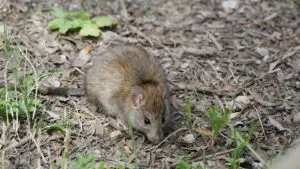
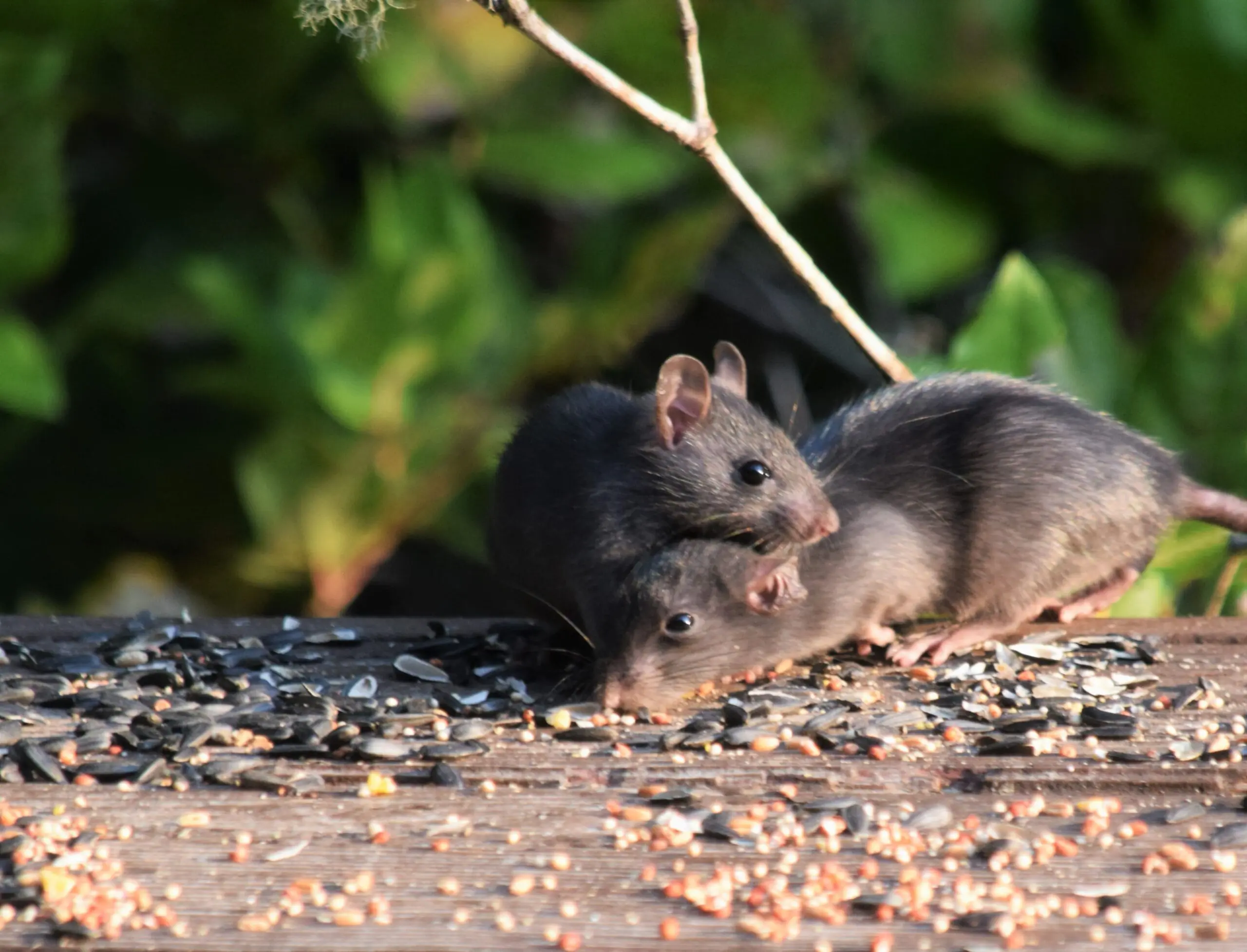
Rodent Basics
What are mice and rats?
Rats are medium-sized, long-tailed rodents. Species of rats are found throughout the order Rodentia, but stereotypical rats are found in the genus Rattus.
Mice are small animals in the order Rodentia, with the most well-known species being the common house mouse (Mus musculus). There are over 70 species of mice and rats widely distributed across North America.
What's the difference between a rat and a mouse?
Both belonging to the rodent family, mice and rats may seem alike but there are clear differences between the two.
Mice are small in build compared to rats which are medium-sized. While both rodents have pointed snouts, mice can be distinguished by their big rounded ears along with their thin body-length tail with a light coating of hair. Whereas, rats have relatively small ears along with thick, scaly tails that vary in length.
At most, mice grow up to 7 inches long, including their tail. Their small heads house small black eyes and they are covered in a brown, gray or white coat.
Rats on the other hand, grow between 10 and 18 inches depending on the type. Their bodies are covered in short fur that might be dark brownish to black or dark gray to black depending on the type of rat.
Rodent Habitats: Identifying a mouse or rat problem
Mice Dwellings:
Mice can survive in many indoor and outdoor environments, however, their natural habitat is outside where they can build a suitable nest out of grass, grains and other materials.
Compared to their indoor counterparts, outdoor mice are usually loners who are defensive of their home and surrounding territory. Males and females come together to mate and then the female mouse cares for the young until they grow and find homes of their own.
By contrast, when mice live indoors, they tend to live in groups under the leadership of an alpha male. Indoor mice often build elaborate nests inside walls, ceilings, attics, and any other void they can find. Anything soft and cozy is fair game for indoor mice to use to craft a nest, including shredded cardboard and paper, rags and insulation. Once they've nested, they'll remain hidden, only venturing out to feed or find fresh water.
Good places to spot mice in the home are in attics, pantries, behind kitchen cabinets, inside furniture, storage boxes or any place infrequently used and secluded.
Rats Territory:
Although highly adaptable and being able to live almost anywhere they find enough food, water and shelter, rats’ habitats are dependent on the species. Cotton rats thrive in spaces with heavy vegetative cover - preferring to live in areas such as grassy fields, ditches, brush, gardens, barns, cabins, and sheds. While the Norway rats can be spotted in places near human environments - attics, basements, crawl spaces, wood piles, and even murky sewers. Being the excellent climbers that they are, rats such as Roof rats can be found nesting inside homes, attics, rafters, roofs, trees, and other elevated spaces. Their nests are known to be ideal for raising vulnerable young all-year-round.
There are two main types of rats that infest structures in the United States, roof rats and Norway rats. Both species of rats are highly adaptable and they can be found within spaces ranging from residential, agricultural and industrial structures and areas. Norway rats are spread through just about every state in the US. Roof rats have a more limited range and are most frequently found in coastal areas.
Decoding Rat Behavior
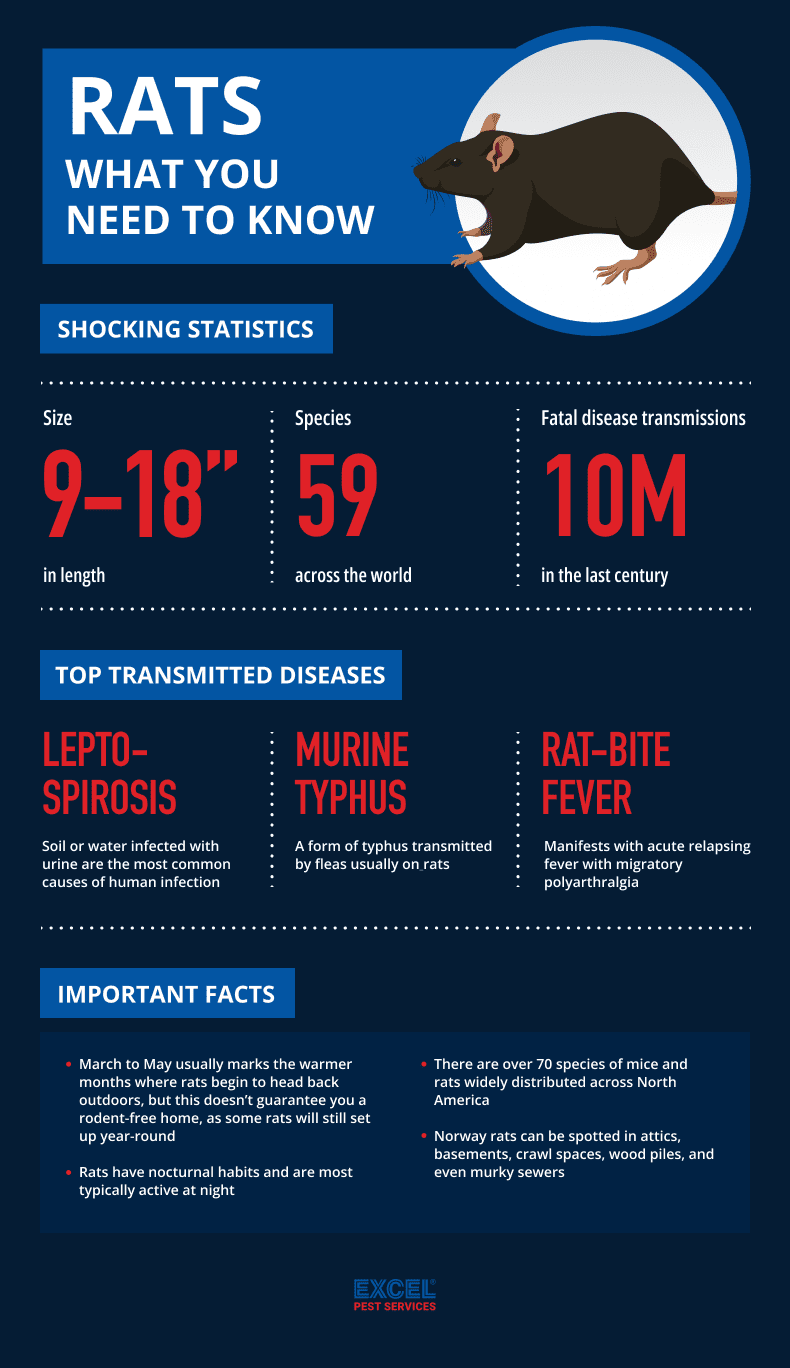
Rats can enter a home at any point throughout the year, due to their breeding during warmer weather, however, rodent season begins with the oncoming of colder months. Anywhere from August to late October rat behavior will change as they stop breeding and start looking for food and warmer spaces to build their nests in your home.
March to May usually marks the warmer months where rats begin to head back outdoors, but this doesn’t guarantee you a rodent-free home, as some rats will still set up year-round.
Ever wondered what’s all that scurrying and scraping noise happening in your ceiling as you turn in for the night? Well, you might just have yourself some visitors who happen to not have guest etiquette. Yes, rats have nocturnal habits and are most typically active at night while you try to get some shut eye.
Understanding Mouse Behavior
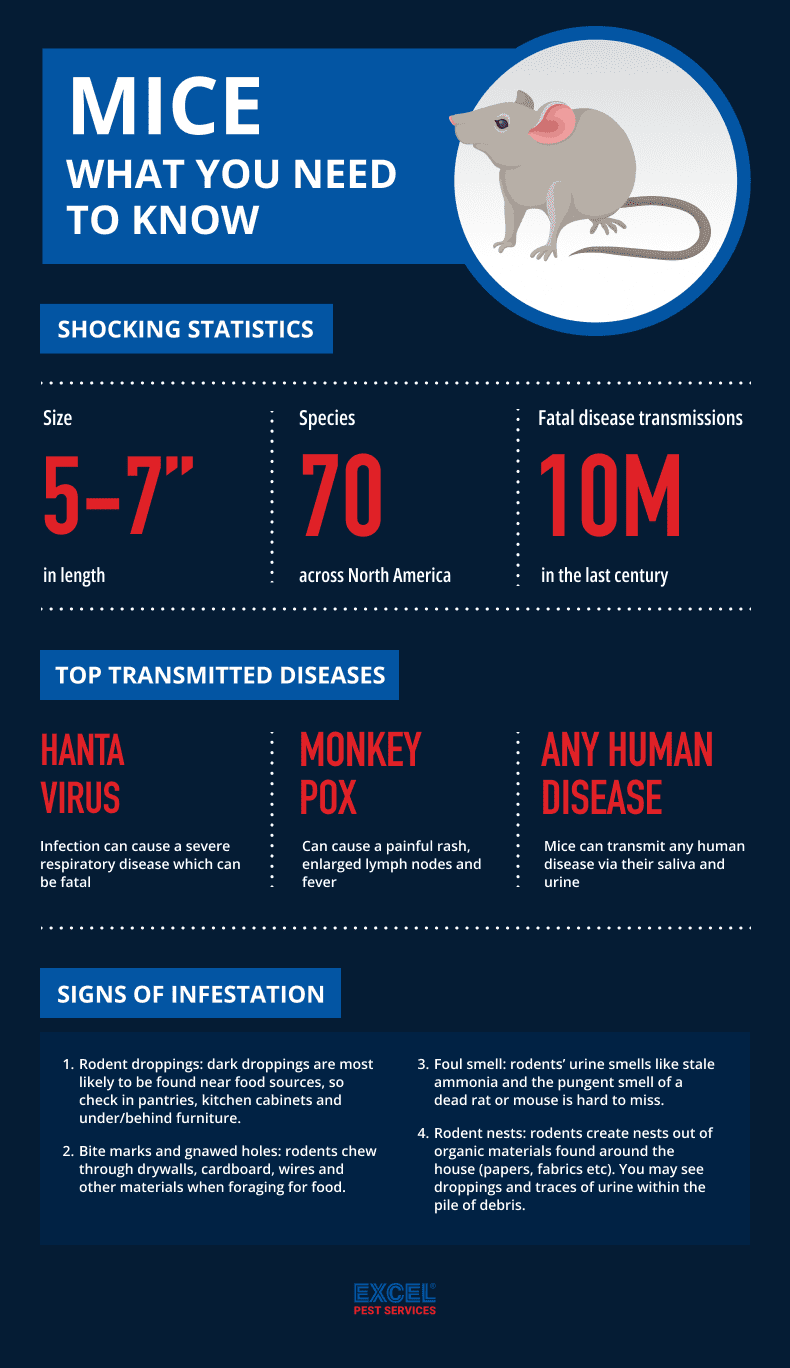
Being from the same family, mouse behavior is similar to that of rats, where they breed in the warmer months and seek out warmer habitats in the colder months.
Common Diseases Carried by Mice and Rats
Though rodent infestations can be quite destructive to property, the most concerning damage is to your health. Disease transmission is a huge concern as rats are considered unsanitary due to their tendency to transmit bacteria and harmful diseases. Rats are carriers of a multitude of diseases from hantavirus to the bubonic plague. Any food items that rats get in contact with are to be discarded because it's contaminated. In addition, the fleas and ticks that live on rats also carry disease that can be passed to humans and pets.
All mice can spread human diseases through their urine, saliva, or droppings. Mouse droppings are rod-shaped and pointed on each end. Deer mice and white-footed mice are especially concerning, as they are known to carry hantavirus.
Can You Catch Diseases from Rodents?
There are a number of health risks to be aware of when dealing with a rat or mice infestation as they carry rodent-borne diseases.
According to the CDC, the diseases spread by rodents include:
- Hantavirus
- Hantavirus Pulmonary Syndrome
- Hemorrhagic Fever with Renal Syndrome
- Lassa Fever
- Leptospirosis
- Lujo Hemorrhagic Fever
- Lymphocytic Choriomeningitis (LCM)
- Monkeypox
- Omsk Hemorrhagic Fever
- Rat-Bite Fever
- Salmonellosis
- South American Arenaviruses (Argentine hemorrhagic fever, Bolivian hemorrhagic fever, Chapare Hemorrhagic Fever, Sabiá-associated hemorrhagic fever, and Venezuelan hemorrhagic fever)
- Sylvatic Typhus
- Tularemia
Hantavirus: Unveiling the Danger
Carried by rodents - cotton rats, rice rats and white-footed mice - hantavirus is a group of viruses that can cause illness in humans. Hantavirus does not infect pets and livestock. The zoonotic infections are spread from wild rodents (that are asymptomatic) that spread the virus into the environment through saliva, urine and droppings. Once in the environment, humans get in contact with it through breathing dust contaminated by rodent droppings, urine, saliva or direct contact (bite or by contaminated dust getting into wounds, nasal passages or eyes).
Hantavirus symptoms usually develop between one and five weeks after exposure to fresh urine, droppings, or saliva of infected rodents. Infection with Hantavirus can progress to Hantavirus Pulmonary Syndrome (HPS), a severe respiratory disease which can be fatal. Early symptoms include fatigue, fever and muscle aches in the thighs, hips, back, and sometimes shoulders. The infected person may also experience headaches, dizziness, chills, and abdominal complaints, such as nausea, vomiting, diarrhoea, and abdominal pain. Four to ten days after the initial phase of illness, the late symptoms of Hantavirus infection develop and HPS may appear. These include coughing and shortness of breath and progression to respiratory distress and failure. The virus has no vaccination or cure.
Leptospirosis: A Closer Look
Leptospirosis is a zoonotic disease caused by pathogenic Leptospira species. They cause infection in animals, and are carried asymptomatically by rodents, especially rats, that will then pass the disease through urine. Soil or water contaminated with infected urine are the most common causes of human infection. Some people infected with leptospirosis will have no symptoms at all, and some people will become severely ill.
Murine Typhus: Symptoms and Prevention
Murine typhus, also known as flea-borne typhus, is a form of typhus transmitted by fleas usually on rats. Most people who are infected do not realize that they have been bitten by fleas.
It is caused by the bacterium Rickettsia typhi, and is transmitted by the fleas that infest rats. The rats maintain the rickettsia by providing it with a host for its entire life cycle. Rats can develop the infection, and help spread the infection to other fleas that bite them,this multiplies the number of infected fleas that can then infect humans. Human infection occurs because of flea-fecal contamination of the bites on human skin.
Symptoms include headache, fever, muscle pain, joint pain, nausea and vomiting. Some patients will develop a discrete rash six days after the onset of signs and some may develop neurological signs such as confusion, stupor, seizures or imbalance. If left untreated the disease can be fatal, but murine typhus is highly treatable with antibiotics. Most people recover fully, but death may occur in the elderly, severely disabled or patients with a compromised immune system.
States most at risk of diseases carried by rodents
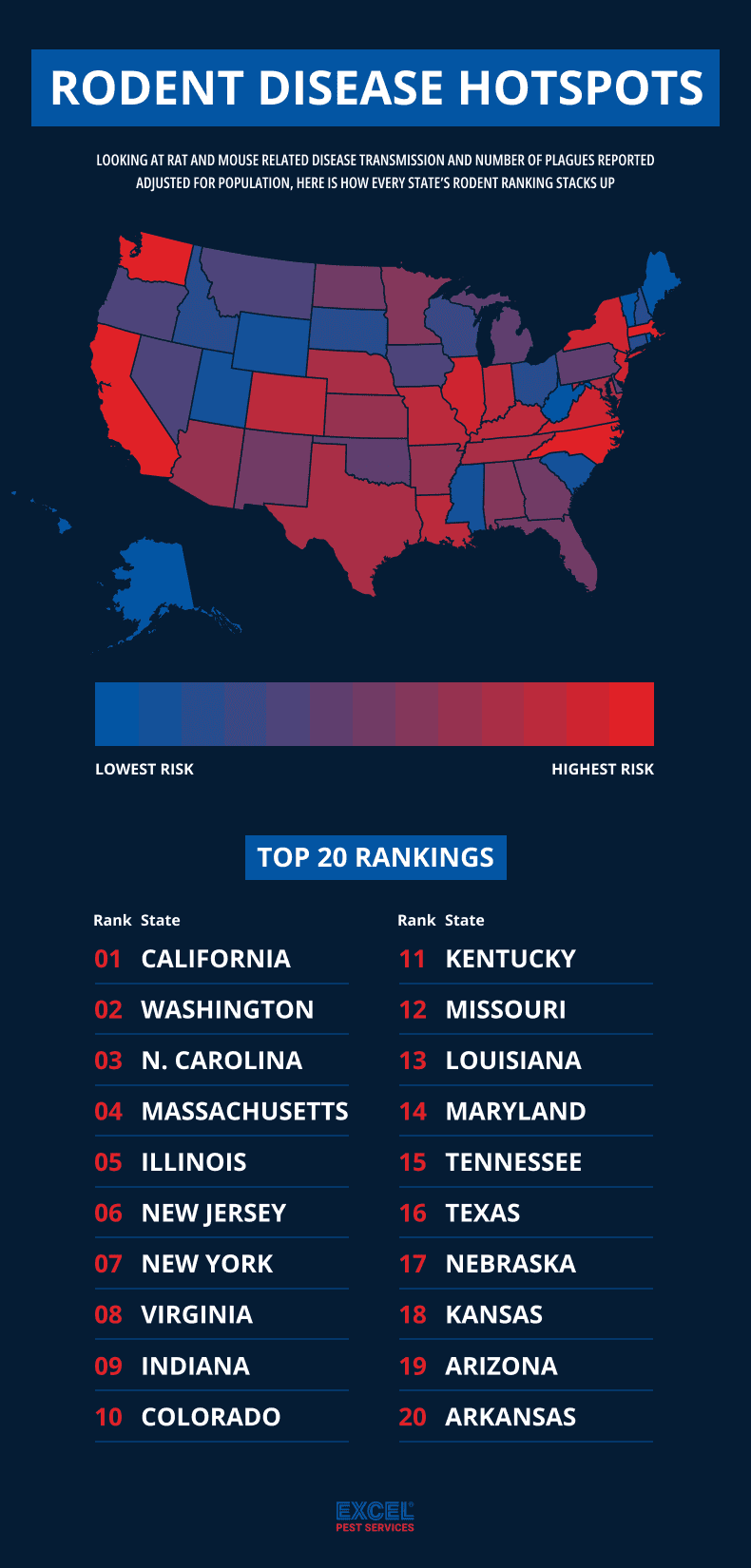
Based on research across the United States, although some rodent-borne diseases might be rare or don’t occur as often anymore there are still some that are still prevalent. We analyzed the most recent state-level data on diseases directly caused by rodents in order to find out which diseases affect Americans the most.
As of 2022 with 29,928 cases, Monkeypox has the highest number of reported cases across the USA, while Hantavirus’ 2021 cases (when the most recent data was published) amounted to only 16. Tularemia accounted for 150 cases in 2019, and the plague had 495 diagnosed cases.
Ranking overall top for rodent-borne diseases is California, with leading cases of Monkeypox at 5,808, while second contender New York boasted 4,300 cases. California also ranked joint fourth with six other states for Hantavirus cases with only 1 case reported in 2021.
Coming in overall second is Washington with an astounding 700 cases of Monkeypox and the state reported no cases of the plague recently.
North Carolina takes third place with 709 Monkeypox cases, 253 cases of the plague in 2020, 1 Tularemia case in 2019 and 0 cases of Hantavirus in 2021. Massachusetts and Illinois make up the remainder of the top 5 respectively.
Risk of rodents and rodent-borne disease in New Jersey
A number of rodents call New Jersey home; the house mouse is one of the most prevalent rodent types in the state. House mice, though not aggressive, can spread disease and illness by contaminating insulation with urine and droppings. Like the house mouse, the white-footed mouse is a vector for disease in the home but mainly on ground-level walls.
Deer mice are also common in New Jersey, and are mostly found hidden in outdoor spaces - garages, sheds, log piles and even that unused car parked outside your home - but once they get indoors then you’re most likely to find them in basements, attics and storage boxes. They are known to be one of the primary carriers of the Hantavirus. Roof rats in the state are mostly found near ports and hitch rides on travelling ships, they are known for the spreading of the bubonic plague. Lastly, the Norway rat is also a regular in New Jersey. Also known as the “sewer rat” this rodent prefers living in subways, sewers and any place alongside human settlements.
Based on the recent data, New Jersey ranked 6th overall with Monkeypox cases (777) ranking 8th, while Tularemia was 12th at 3 cases, Hantavirus and the Plague had 0 cases.
Risk of rodents and rodent-borne disease in Florida
Rodents common in Florida are, namely, House mice, Deer mice, Roof rats and Norway rats. These pests are mainly drawn to Florida’s warm climates, which will have them coming into your home in search of water, shelter on those rainy, cold snap days and food. With Florida being a magnet for tropical storms, hurricanes and floods amongst other natural disasters - leaving behind a lot of debris that becomes a breeding ground for rodent nesting areas.
In the research, Florida boasts 2,902 cases of Monkeypox, ranking it 4th. In better news, the state reported 0 cases recently for Hantavirus, Tularemia and the Plague.
Rodent Infestation Prevention
Recognizing Mouse and Rat Signs
Dealing with an infestation is the last thing anyone wants in their living space. Although the little critters move fast and are nocturnal - almost making it difficult to encounter them, they aren’t as invisible as they’d like to be. Spotting a rat or mouse infestation is made easier by the following signs:
- Rodent droppings: the most obvious - dark droppings are most likely to be found near food sources, so be sure to check in pantries, kitchen cabinets and under/behind furniture.
- Bite marks and gnawed holes: rodents chew through drywalls, cardboard, wires and other materials when foraging for food. If food packages, walls and any enclosed spaces have holes mimicking rodent bite marks then you most likely have a rodent issue at hand.
- Foul smell: not seeing any droppings but getting a strong foul smell around the house? Well this could be another sign of rodent presence. When an infestation is present then the rodents’ urine is most likely to stand out and smell like stale ammonia. Then there’s the pungent smell of a dead rat or mouse…hard to miss considering how the smell will linger for days or weeks even.
- Rodent nests: these are hard to miss considering how the critters make nests out of organic materials found around the house (papers, fabrics etc). If you discover a pile of these items clumped together just know a rodent has made itself at home. You may see droppings and traces of urine within the pile of debris.
Why Do I Have a Rodent Problem?
One or both of these two things could be attracting mice and rats to your home/establishment - food and shelter.
The reality is if you don’t tidy up properly and food waste is left behind on counters or floors then rodents are bound to find their supply of food in your living space. Secondly, rats and mice seek shelter from your home, particularly to avoid the harshness of the colder months as well as to find warm spaces to raise their young
Small holes to and from the outside can serve as a gateway for rodents to invade your home. All it takes is a gap of half an inch or more for a rat to enter the indoors, while a mouse only needs a quarter of an inch.
How to Get Rid of Mice and Rats
Getting rid of rodents can be a lengthy process when you undertake it alone and decide to go the DIY route. These unwelcome house guests have a knack for outrunning or rather will scurry past even the fastest shoe or broom thrown their way. Since they breed year-round, it’s easy for a few rats to become a large infestation in no time. The best thing to do is to call in professional pest control services to assist you and get rid of the infestation, and Excel Termite and Pest Control is one such provider.
Being pests that are known to carry disease-causing pathogens, it is advisable to not try to trap rodents on your own as you may not have the correct gear and equipment to do so safely without causing diseases carried by rats and mice to be a health hazard to yourself and family.
What to Expect From Professional Rodent Extermination
Once you make your appointment with us this is what you can expect.
- Thorough site inspection: a professional will come to your space to inspect the interior and exterior of your property. Here they will be able to determine how the rodents are accessing your home, what attracts them and what steps need to be taken to proactively and reactively deal with the infestation.
- Blocking and limiting entry: if there are any holes, cracks or entry points then the professional will advise on sealing solutions that can block entrance from outside. They’ll also look out for any nearby shelter points that rodents might be found in - such as dumpsters, and fields of vegetation etc, so cutting these down or making sure it’s regularly cleaned can help keep rodents away from your property as well.
- Long-term maintenance: A large part of pest control is catching any rodents that have already infiltrated your building. A pest control professional should be setting and regularly checking anti-tamper traps at strategic locations around your property, be it for residential pest control or commercial pest control services. Accurate records should be kept, detailing the types of pests caught in your facility, when these pests were found, and how to assess the effectiveness of your pest control procedures. Contact us for all your commercial and residential pest control needs to maintain a pest-free environment.





